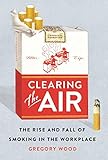Clearing the air : the rise and fall of smoking in the workplace / Gregory Wood.
Material type: TextPublication details: Ithaca : ILR Press, an imprint of Cornell University Press, (c)2016.Description: 1 online resource (257 pages) : illustrationsContent type:
TextPublication details: Ithaca : ILR Press, an imprint of Cornell University Press, (c)2016.Description: 1 online resource (257 pages) : illustrationsContent type: - text
- computer
- online resource
- 9781501706349
- HF5549 .C543 2016
- HF5549
- COPYRIGHT NOT covered - Click this link to request copyright permission: https://lib.ciu.edu/copyright-request-form
| Item type | Current library | Collection | Call number | URL | Status | Date due | Barcode | |
|---|---|---|---|---|---|---|---|---|
 Online Book (LOGIN USING YOUR MY CIU LOGIN AND PASSWORD)
Online Book (LOGIN USING YOUR MY CIU LOGIN AND PASSWORD)
|
G. Allen Fleece Library ONLINE | Non-fiction | HF5549.5.55 (Browse shelf(Opens below)) | Link to resource | Available | ocn960833795 |
Includes bibliographies and index.
Introduction : addicted : nicotine and working-class history -- Reformers, employers, and the dangers of working-class smoking -- Smoking bans and shop floor resistance during the early twentieth century -- Workers, management, and the right to smoke during World War II -- Thank you for not smoking : anti-smoking politics in postwar workplaces -- "Exiled smoking" and the making of smoke-free workplaces -- Organized labor and the problem of "smokers' rights" -- Conclusion : quitting smoking and the endurance of nicotine.
Introduction: Nicotine and Working-Class History -- Reformers, Employers, and the Dangers of Working-Class Smoking -- Smoking Bans and Shop Floor Resistance during the Early Twentieth Century -- Workers, Management, and the Right to Smoke during World War II -- Antismoking Politics in Postwar Workplaces -- "Exiled Smoking" and the Making of Smoke-Free Workplaces -- Organized Labor and the Problem of "Smokers' Rights" -- Conclusion: Quitting Smoking and the Endurance of Nicotine.
In Clearing the Air, Gregory Wood examines smoking's importance to the social and cultural history of working people in the twentieth-century United States. Now that most workplaces in the United States are smoke-free, it may be difficult to imagine the influence that nicotine addiction once had on the politics of worker resistance, workplace management, occupational health, vice, moral reform, grassroots activism, and the labor movement. The experiences, social relations, demands, and disputes that accompanied smoking in the workplace in turn shaped the histories of antismoking politics and tobacco control.The steady expansion of cigarette smoking among men, women, and children during the first half of the twentieth century brought working people into sustained conflict with managers' demands for diligent attention to labor processes and work rules. Addiction to nicotine led smokers to resist and challenge policies that coldly stood between them and the cigarettes they craved. Wood argues that workers' varying abilities to smoke on the job stemmed from the success or failure of sustained opposition to employer policies that restricted or banned smoking. During World War II, workers in defense industries, for example, struck against workplace smoking bans. By the 1970s, opponents of smoking in workplaces began to organize, and changing medical knowledge and dwindling union power contributed further to the downfall of workplace smoking. The demise of the ability to smoke on the job over the past four decades serves as an important indicator of how the power of workers' influence in labor-management relations has dwindled over the same period.
COPYRIGHT NOT covered - Click this link to request copyright permission:
There are no comments on this title.
